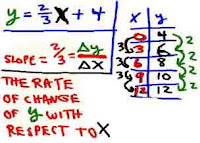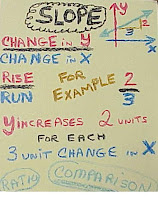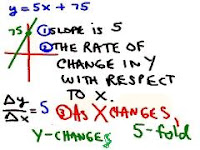FINDING the EQUATION of a LINE
What is this SLOPE THING?
Suppose we want to buy some T-shirts.
same amount. There is a charge
(an initial fee)
for setting up the logo for the order.
and 100 shirts would cost $633.
What is the COST for each shirt?
Dollars per Shirt!
(The SLOPE OF A LINE)
$540 divided by 90 shirts gives
a RATE (Cost per Shirt) of $6.00 per shirt.
Why then do 10 shirts at $6 each cost $93?
Because there is a set-up fee of $33.
The Cost formula that Mr. Smith uses is:
Total Cost = ( $6 ) times # of shirts PLUS $33
We could represent this with the equation:
y = 6 x + 33
(Note: y depends on x for its value!)
$$$$$$$$$$$$$$$$$$$$$$$$$$$$$$$
Take a look at the set of ordered pairs:
{ (3,11) (4,13) (5,15) (6,17)}
We notice that when X changes one unit
(11 to 13). As X changes 2 units (3 to 5),
Y changes 4 units (11 to 15).
NOTE:
We are not saying that the values for y
are twice as big as the values for x.
We are talking about changes in y and x.
We call this the RATE OF CHANGE OF Y
WITH RESPECT TO X. Graphing these points
onto the xy-plane and connecting the points
with a line we have what is called a line
with SLOPE of 2. The EQUATION that these
points SATISFY is y = 2x + 5. Notice the
SLOPE of 2 is situated next to x.
Picking a point on the graph and moving
3 units to the RIGHT (RUN)
and then moving
6 units UP (RISE) we will land
us back onto the line.
The RISE is 6 and the RUN is 3.
the FRACTION (RATIO)
RISE/RUN EQUALS 2.
One definition for the slope of a LINE
m = RISE/RUN.
How about the graph of the equation
y = (3/4)x - 1
Some of the ordered pairs that satisfy
this equation are {(4,2) (8,5) (12,8) ...}
When x changes 4 units, y changes 3 units.
The RATIO of 3 to 4 represents the
change in y with respect to the change in x.
THE CHANGE IN Y over the CHANGE in x is 3/4.
The slope of the graph of this equation is 3/4.
The SLOPE of the graph of the solutions to:
(i) a LINEAR FUNCTION f(x) = mx + b
(ii) an equation in the form Ax + By = C
(iii) or in the form y = mx + b
..........SLOPE is the rate that y changes
with respect to a change in x
..........In other words,
m = (y2-y1) / (x2-x1)
or m = change of y divided by the change in x
-----the values for x change by (x2-x1)
and the corresponding y's change by (y2-y1)



LINK: Back to Contents
